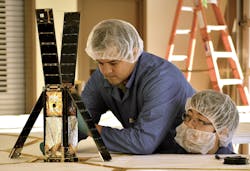A proposal funded by NASA’s Innovative Advanced Concepts program outlines an approach for exploring asteroids and small solar bodies with a fleet of nanosatellites.
The “Swarm Flyby Gravimetry” project was proposed by Justin Atchison, a senior fellow at the Johns Hopkins Applied Physics Laboratory. The proposed system merges the idea of swarm robotics with that of a planetary flyby mission.
The system involves a main satellite module releasing a swarm of nanosatellites – or probes – around a small asteroid. Tracking the probes within the asteroid’s gravity field will generate a series of mini-measurements, which can then be combined and interpreted. This information, Atchison said, could be used to calculate the asteroid’s mass distribution, porosity, and underlying composition.
To track the nanosatellites, Atchison has a few ideas. The main satellite could track the probes optically, using reflected sunlight to calculate their trajectories. Another option is to transmit a radar pulse to the probes and measure the return signal to obtain range information. A third option is to equip the main satellite module with an onboard oscillator and reflect Lidar signals off the probes.
The main advantage of these methods, according to the Atchinson's proposal, is that they require nothing of the probes other than being reflective. The probes will have to be compact and low-cost, as none of them will be retrieved after being deployed.
A low-cost design will also enable the probes to delve deeper in the asteroids gravity well, and even crash into the asteroid. And if “you need more measurements,” Atchison said in a recent presentation to the NIAC board, “you launch more probes.”
The proposal was selected for additional research and funding under Phase II of the NIAC program. The project will receive about $500,000 in funding over the next two years. Atchinson said that the money will for computer simulations to test the mission’s feasibility. In addition, Atchison and his research team will focus on building prototypes of the nanosatellites and a mechanism to disperse them around the asteroid.
The second phase of the NIAC program granted funding to seven proposals selected on their potential to transform deep-space exploration. All entries are still in early stages of development. And NASA predicts that most of the proposals, including the “Swarm Flyby Gravimetry” project, will need at least 10 more years to become practical.
About the Author

James Morra
Senior Editor
James Morra is the senior editor for Electronic Design, covering the semiconductor industry and new technology trends, with a focus on power electronics and power management. He also reports on the business behind electrical engineering, including the electronics supply chain. He joined Electronic Design in 2015 and is based in Chicago, Illinois.
